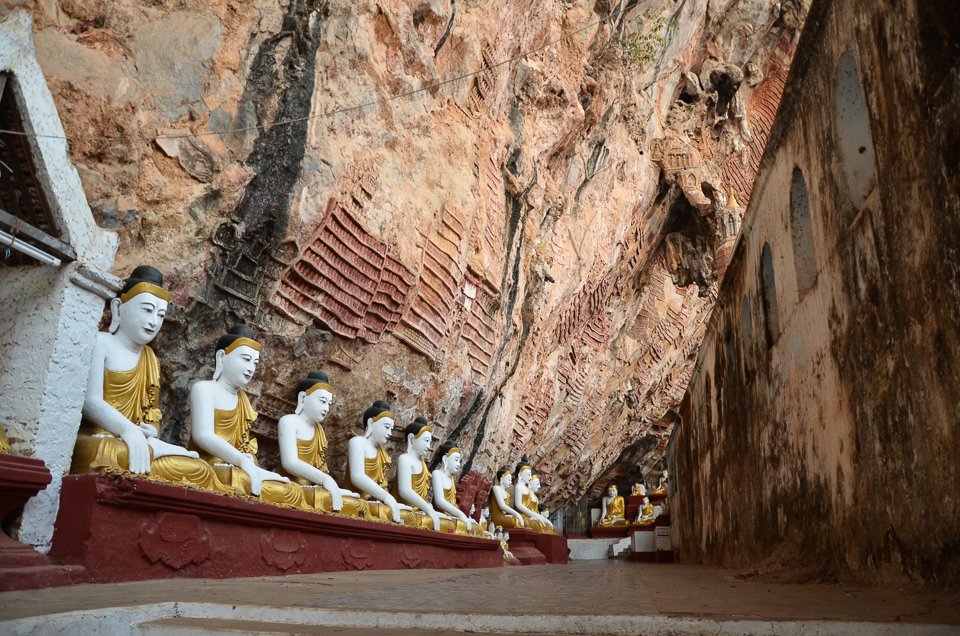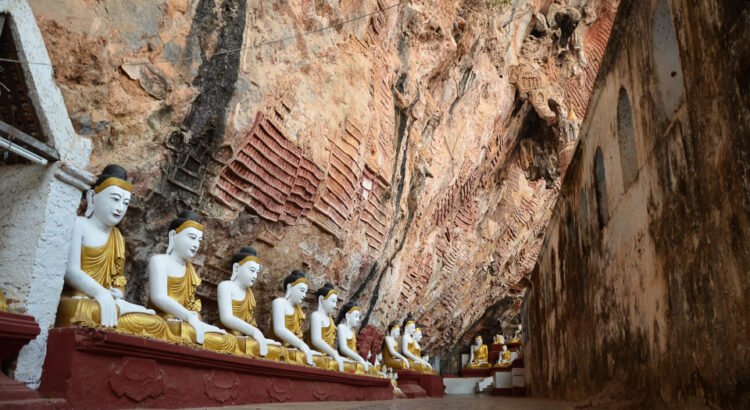
Tucked away in Myanmar’s southeastern Kayin State, Hpa-An is one of Southeast Asia’s most beautiful yet overlooked destinations. Framed by jagged limestone mountains, cloaked in rice fields that sway with the rhythm of the breeze, and dotted with spiritual cave temples, this riverside town offers a slice of tranquility that feels untouched by time. More than just a scenic escape, Hpa-An is a place where Buddhist devotion, natural beauty, and local hospitality combine to create a deeply moving experience for every traveler who ventures off the beaten path.
In Hpa-An, life unfolds gently—through the soft chants of monks at sunrise, the golden glow of evening over Mount Zwegabin, and the endless smiles of the Kayin people who warmly welcome you into their rhythm. Whether you’re navigating narrow cave corridors filled with Buddha statues or cycling through paddies with mountain silhouettes in the distance, Hpa-An offers something far rarer than excitement: a genuine sense of peace.
The Enchanting First Glimpse: Arrival in Hpa-An
Your journey to Hpa-An will likely bring you from bustling Yangon or the Thai border at Myawaddy. As you leave the chaos of city streets behind, the landscape gradually shifts—urban sprawl gives way to emerald fields, sleepy villages, and finally, the sharp limestone peaks that signal your arrival in Hpa-An.
The Thanlwin River, Myanmar’s longest, gently curves along the town’s edge. Simple wooden boats drift along its surface, while the town itself is small enough to explore on foot, bicycle, or by renting a motorbike for adventures farther afield. You’ll quickly realize: this isn’t a place for rushing. It’s a place for wandering, wondering, and letting go.
Limestone Cathedrals: The Sacred Caves of Hpa-An
Hpa-An’s most compelling sights lie beneath its surface—in the many sacred caves that pierce its limestone hills, transformed over centuries into places of worship, reflection, and mystery.
1. Saddan Cave
Perhaps the most famous is Saddan Cave, a dramatic, cathedral-like cavern filled with hundreds of Buddha images and pagodas tucked into nooks and crannies. The journey inside feels almost cinematic: walk through the massive entrance, your footsteps echoing as bats flit overhead and sunlight filters through cracks in the rock. The further in you go, the more surreal it becomes.
Eventually, you’ll emerge on the other side of the mountain to find a hidden lake where you can take a small wooden boat through rice paddies back to the entrance. It’s more than a cave—it’s an experience that seamlessly fuses spirituality and natural wonder.
2. Kawgun Cave
Just outside town, Kawgun Cave impresses with its walls covered in thousands of tiny Buddha images, some dating back to the 7th century. These miniature carvings are arranged in elaborate patterns across the stone walls, a testament to centuries of devotion and artistic labor.
3. Yathaypyan and Bayin Nyi Caves
Other notable caves like Yathaypyan Cave (with stunning valley views from the exit) and Bayin Nyi Cave (featuring a natural hot spring at its base) are just a short drive away, making it easy to design a full day of cave-hopping adventures, each with its own atmosphere, legends, and spiritual weight.
Zwegabin Mountain: A Sacred Ascent
Towering 722 meters above the town, Mount Zwegabin is Hpa-An’s most iconic landmark and spiritual heart. The mountain is sacred to the local Karen people, and its summit is crowned with a shimmering Buddhist monastery.
Climbing Zwegabin is not for the faint of heart—the path includes thousands of stone steps, often steep and uneven. Yet those who rise early and begin the trek before dawn are rewarded not only with the spiritual accomplishment of the climb but also with breathtaking sunrise views as the fog lifts from the valleys below.
Along the way, you’ll pass peaceful monk statues, shrines, and fellow pilgrims making the journey with quiet reverence. Reaching the summit, with its golden pagoda and panoramic views, you feel as though you’re suspended between earth and sky.
A Patchwork of Green: Cycling Through Rice Fields
Hpa-An’s surroundings offer some of the most idyllic rural landscapes in Southeast Asia. Renting a bicycle or scooter, you can set off down dirt roads that wind through villages, across bamboo bridges, and into rice paddies stretching as far as the eye can see. During planting season, the fields are shimmering mirrors of water, reflecting the sky and mountains. In harvest season, they glow a rich gold.
You’ll pass water buffalo, curious children waving from stilted houses, and farmers tending their crops with quiet determination. Stops along the way might include tea stalls, roadside shrines, and random moments of magic: a woman offering you a coconut, a monk inviting you into a monastery, a spontaneous smile exchanged with someone you’ll never see again.
This is Hpa-An at its most real and most beautiful—not curated, not commercial, but profoundly human.
Thanlwin River: A Mirror of the Sky
The Thanlwin River, also known as the Salween, flows through Hpa-An like a lifeline. It’s best appreciated in the early morning or at sunset, when the light turns golden and the river becomes a shimmering mirror for the dramatic landscape that surrounds it.
Boat trips along the river—especially between Hpa-An and neighboring Mawlamyine—are a scenic and meditative way to experience the region. Watch as fishermen cast their nets, monks walk barefoot along the banks, and waterbirds skim the surface of the current.
Even just sitting by the riverside with a cup of tea or a bowl of mohinga (Myanmar’s beloved noodle soup) becomes a moment of connection with nature and local life.
The Buddhist Soul of Hpa-An
Myanmar is a deeply Buddhist country, and Hpa-An is no exception. Everywhere you turn, you’ll see monks in crimson robes, ancient stupas, and small roadside shrines. But here, spirituality feels organic, lived-in, and welcoming—less about spectacle and more about quiet devotion.
You might stumble upon a novice monk ceremony, or be invited into a temple to witness chanting or alms preparation. Locals will explain rituals without expectation or condescension. There is a gentle warmth and openness in how religion is practiced and shared in Hpa-An that makes it accessible, even to non-Buddhists.
The Kyauk Kalap Pagoda, perched on a narrow limestone pinnacle rising from an artificial lake, is a must-visit. At sunset, the reflection of the pagoda and mountain in the water feels almost otherworldly, yet it’s the serenity of the place that stays with you.
Hospitality from the Heart
Perhaps the most memorable aspect of Hpa-An is not its caves or mountains, but its people. The Kayin (Karen) community that calls this place home is known for their genuine kindness, curiosity, and resilience. Despite decades of political unrest in the region, the people of Hpa-An greet visitors with open arms and open hearts.
Whether staying in a family-run guesthouse, chatting with your motorbike rental guy, or buying snacks from a street vendor, you’ll encounter a level of warmth that feels almost familial. Many travelers report being invited into homes, offered free rides, or taught a few words of the Kayin language—all without pretense or expectation.
In a world where tourism often feels transactional, Hpa-An offers something pure: human connection.
Where to Stay and Eat
Hpa-An may be off the tourist trail, but its infrastructure has improved in recent years. Comfortable guesthouses and boutique hotels—such as Keinnara Lodge, Little Hpa-An Hostel, and Sojourn Guest House—offer cozy, scenic stays with mountain views and local charm.
For food, try local eateries serving Kayin specialties like bamboo shoot curry, spicy pickled tea leaf salads, and river fish grilled with herbs. Street stalls offer snacks like deep-fried samosas, steamed buns, and sugarcane juice. Western options are limited but growing, often served in cafés run by expats or entrepreneurial locals.
Don’t miss the chance to sip laphet yay (Burmese tea) with condensed milk at a local teahouse—it’s more than a drink; it’s a ritual of belonging.
Why Hpa-An Is Worth the Journey
So why should you visit Hpa-An? Because it’s authentic without trying to be, beautiful without being boastful, and full of meaning without needing an itinerary. It’s a town where natural wonder, spiritual depth, and cultural warmth exist not as separate attractions, but as one interconnected way of life.
Here, travel becomes a quiet revelation. There’s no rush to tick off landmarks or hunt for Instagram shots. Instead, you’re invited to slow down, observe, listen, and simply be.
Conclusion: The Peaceful Heart of Myanmar
In Hpa-An, every mountain holds a legend, every cave whispers history, and every encounter adds something to your understanding of Myanmar’s soul. It’s a place that teaches without preaching, touches without overwhelming, and lingers in memory long after you’ve left.
So if you’re searching for a place that restores your sense of wonder, grounds you in humanity, and awakens your spirit, discover Hpa-An. You won’t find crowds or clichés—only caves, rice fields, limestone peaks, and the gentle beauty of life lived slowly.




